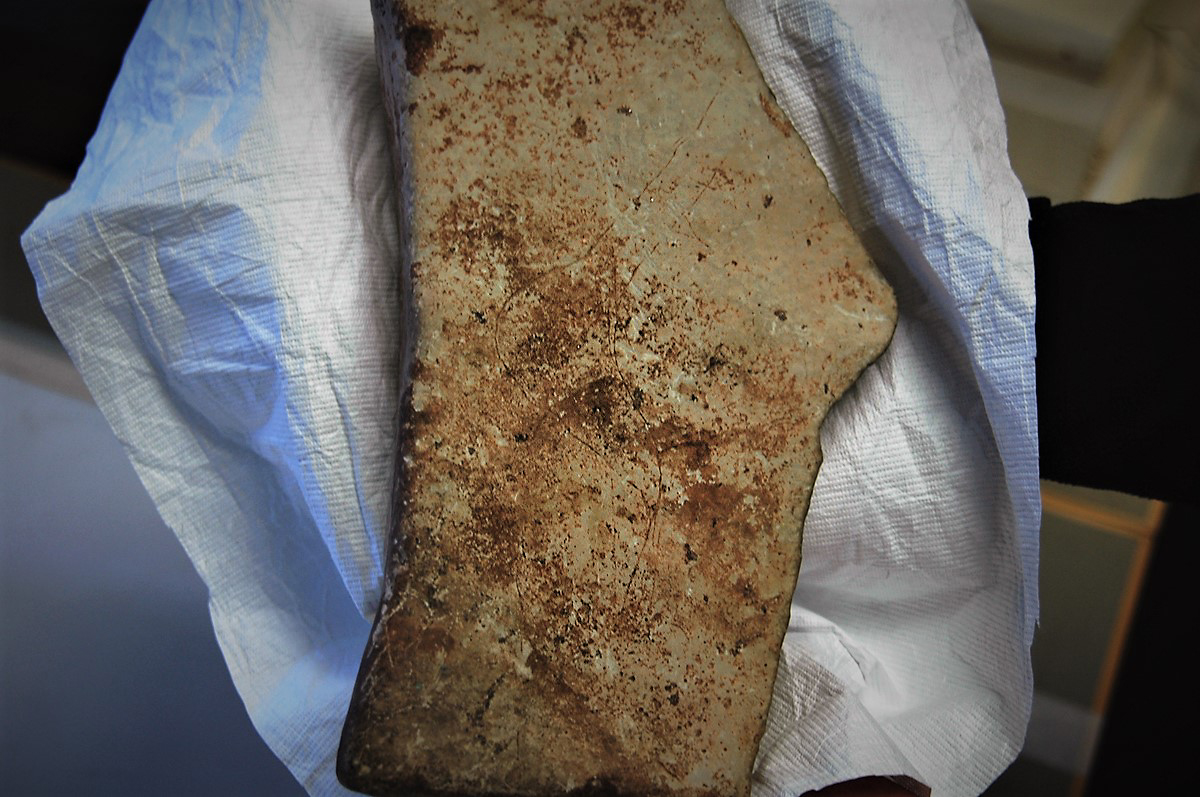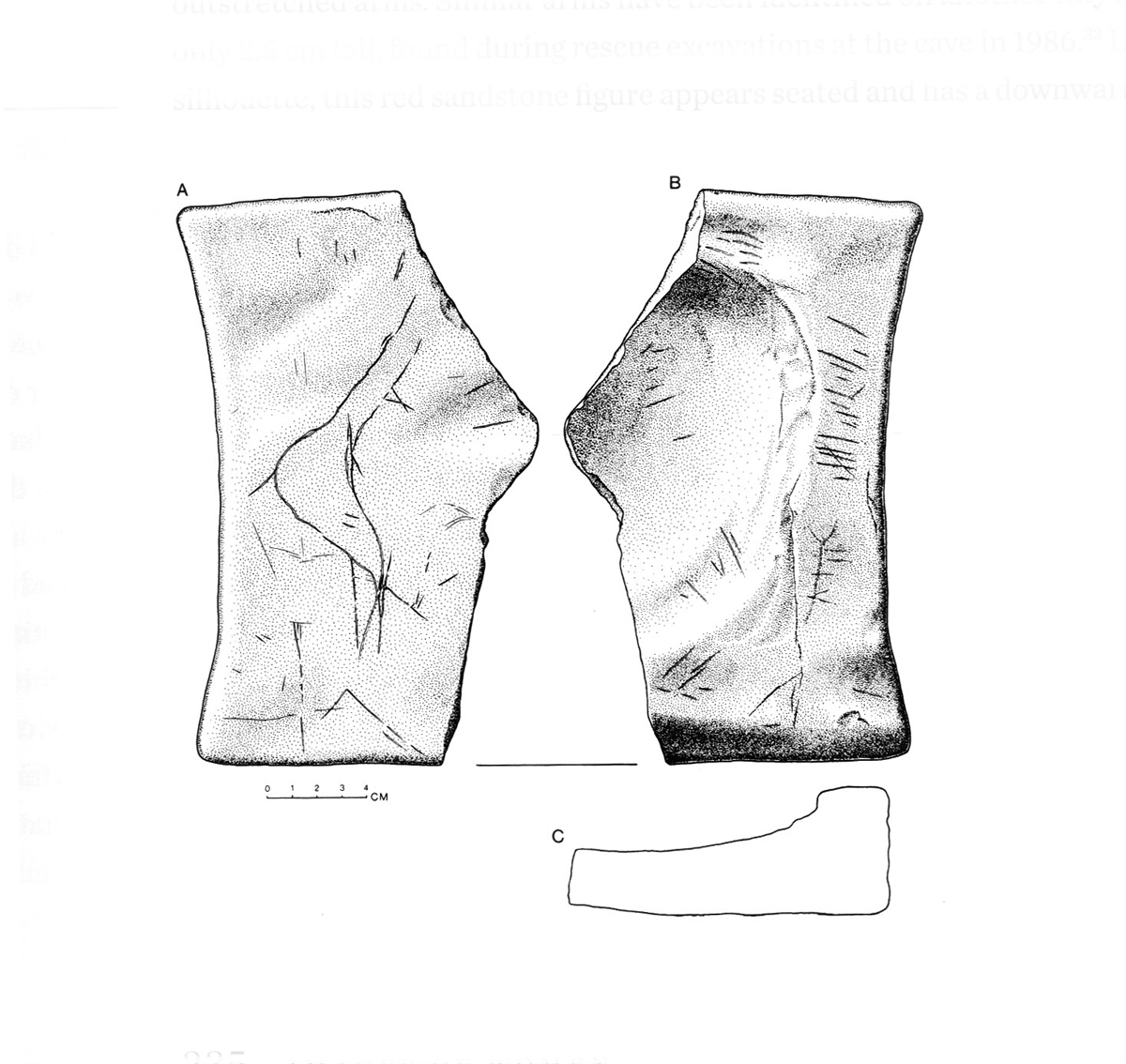


In 1991 at the British Museum a naturally dished and utilized but broken limestone slab, discovered in Courbet Cave in the Aveyron Valley in France, that had always been stored on its flat side (A) was turned over for inspection, revealing previously unrecorded incised lines.

The lines depict the the right profile of the torso, hips, thighs and (probably) breast of a woman.
Ice Age incised figure from Courbet Cave @britishmuseum https://t.co/NUAJFOy8qH #IceAge #archaeology #France pic.twitter.com/GaAPSXjKfL
— Bradshaw Foundation (@BradshawFND) November 29, 2017
Within the dished surface of the slab (B & C) there are signs of burning - it had been used as a lamp.

The female silhouette is depicted with sylized simplicity and artistic confidence. As usual with such figures, there is no head. The incised straight line of the back flows confidently into the curved line of the buttocks and thigh.

Abstracting the female body to reflect beauty through simplicity of line is well known in modern art, such as Picasso's Desmoiselles d'Avignon (above); interesting to observe this artistic and aesthetic technique being employed during the late glacial period about 13,500 radiocarbon years ago. Other similar examples have been discovered in some eighteen sites in France, Germany and Poland, as well as on the walls of about fourteen caves from the same regions.
Ice Age Art - Arrival of the modern mind by Jill Cook:
http://www.bradshawfoundation.com/books/ice_age_art.php
See more Ice Age art:
http://www.bradshawfoundation.com/sculpture/index.php
by Bradshaw Foundation
Wednesday 23 July 2025
by Bradshaw Foundation
Thursday 29 May 2025
by Bradshaw Foundation
Monday 03 February 2025
by Bradshaw Foundation
Friday 09 August 2024
by Bradshaw Foundation
Wednesday 24 July 2024
by Bradshaw Foundation
Thursday 04 July 2024
by Bradshaw Foundation
Monday 01 July 2024
by Bradshaw Foundation
Wednesday 20 March 2024
by Bradshaw Foundation
Tuesday 13 February 2024
by Bradshaw Foundation
Tuesday 13 February 2024
by Bradshaw Foundation
Thursday 01 February 2024
by Bradshaw Foundation
Tuesday 28 November 2023
by Bradshaw Foundation
Thursday 23 November 2023
by Bradshaw Foundation
Monday 20 November 2023
by Bradshaw Foundation
Tuesday 31 October 2023
by Bradshaw Foundation
Thursday 26 October 2023
by Bradshaw Foundation
Wednesday 23 July 2025
by Bradshaw Foundation
Thursday 29 May 2025
by Bradshaw Foundation
Monday 03 February 2025
by Bradshaw Foundation
Friday 09 August 2024
by Bradshaw Foundation
Wednesday 24 July 2024
by Bradshaw Foundation
Thursday 04 July 2024
by Bradshaw Foundation
Monday 01 July 2024
by Bradshaw Foundation
Wednesday 20 March 2024
by Bradshaw Foundation
Tuesday 13 February 2024
by Bradshaw Foundation
Tuesday 13 February 2024
by Bradshaw Foundation
Thursday 01 February 2024
by Bradshaw Foundation
Tuesday 28 November 2023
by Bradshaw Foundation
Thursday 23 November 2023
by Bradshaw Foundation
Monday 20 November 2023
by Bradshaw Foundation
Tuesday 31 October 2023
by Bradshaw Foundation
Thursday 26 October 2023
Friend of the Foundation











